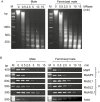Epigenetic aspects of floral homeotic genes in relation to sexual dimorphism in the dioecious plant Mercurialis annua
- PMID: 31504768
- PMCID: PMC6859717
- DOI: 10.1093/jxb/erz379
Epigenetic aspects of floral homeotic genes in relation to sexual dimorphism in the dioecious plant Mercurialis annua
Abstract
In plants, dioecy characterizes species that carry male and female flowers on separate plants and it occurs in about 6% of angiosperms; however, the molecular mechanisms that underlie dioecy are essentially unknown. The ability for sex-reversal by hormone application raises the hypothesis that the genes required for the expression of both sexes are potentially functional but are regulated by epigenetic means. In this study, proteomic analysis of nuclear proteins isolated from flower buds of females, males, and feminized males of the dioecious plant Mercurialis annua revealed differential expression of nuclear proteins that are implicated in chromatin structure and function, including floral homeotic proteins. Focusing on floral genes, we found that class B genes were mainly expressed in male flowers, while class D genes, as well as SUPERMAN-like genes, were mainly expressed in female flowers. Cytokinin-induced feminization of male plants was associated with down-regulation of male-specific genes concomitantly with up-regulation of female-specific genes. No correlation was found between the expression of class B and D genes and the changes in DNA methylation or chromatin conformation of these genes. Thus, we could not confirm DNA methylation or chromatin conformation of floral genes to be the major determinant regulating sexual dimorphisms. Instead, determination of sex in M. annua might be controlled upstream of floral genes by one or more sex-specific factors that affect hormonal homeostasis. A comprehensive model is proposed for sex-determination in M. annua.
Keywords: Mercurialis annua; Chromatin; DNA methylation; cytokinin; dioecy; epigenetics; feminization; floral homeotic gene; nuclear proteome; sex-determination.
© The Author(s) 2019. Published by Oxford University Press on behalf of the Society for Experimental Biology.
Figures








Similar articles
-
Functional analysis of B and C class floral organ genes in spinach demonstrates their role in sexual dimorphism.BMC Plant Biol. 2010 Mar 12;10:46. doi: 10.1186/1471-2229-10-46. BMC Plant Biol. 2010. PMID: 20226063 Free PMC article.
-
A functional decomposition of sex inconstancy in the dioecious, colonizing plant Mercurialis annua.Am J Bot. 2019 May;106(5):722-732. doi: 10.1002/ajb2.1277. Am J Bot. 2019. PMID: 31081926
-
Sexual dimorphic floral development in dioecious plants revealed by transcriptome, phytohormone, and DNA methylation analysis in Populus tomentosa.Plant Mol Biol. 2013 Dec;83(6):559-76. doi: 10.1007/s11103-013-0108-2. Epub 2013 Jul 17. Plant Mol Biol. 2013. PMID: 23860796
-
Regulatory mechanisms for floral homeotic gene expression.Semin Cell Dev Biol. 2010 Feb;21(1):80-6. doi: 10.1016/j.semcdb.2009.11.012. Epub 2009 Nov 13. Semin Cell Dev Biol. 2010. PMID: 19922812 Review.
-
Molecular mechanisms of floral organ specification by MADS domain proteins.Curr Opin Plant Biol. 2016 Feb;29:154-62. doi: 10.1016/j.pbi.2015.12.004. Epub 2016 Jan 21. Curr Opin Plant Biol. 2016. PMID: 26802807 Review.
Cited by
-
Differential DNA methylation and gene expression during development of reproductive and vegetative organs in Ilex species.J Plant Res. 2021 May;134(3):559-575. doi: 10.1007/s10265-021-01279-3. Epub 2021 Mar 23. J Plant Res. 2021. PMID: 33759060
-
Potentials and Challenges of Genomics for Breeding Cannabis Cultivars.Front Plant Sci. 2020 Sep 25;11:573299. doi: 10.3389/fpls.2020.573299. eCollection 2020. Front Plant Sci. 2020. PMID: 33101342 Free PMC article. Review.
-
Mitochondrial genomes do not appear to regulate flowering pattern/reproductive strategy in Cannabis sativa.AoB Plants. 2021 Oct 30;14(3):plab068. doi: 10.1093/aobpla/plab068. eCollection 2022 Jun. AoB Plants. 2021. PMID: 35558164 Free PMC article.
-
Identifying Genes Associated with Female Flower Development of Phellodendron amurense Rupr. Using a Transcriptomics Approach.Genes (Basel). 2023 Mar 6;14(3):661. doi: 10.3390/genes14030661. Genes (Basel). 2023. PMID: 36980934 Free PMC article.
-
Epigenetics drive the evolution of sex chromosomes in animals and plants.Philos Trans R Soc Lond B Biol Sci. 2021 Jun 7;376(1826):20200124. doi: 10.1098/rstb.2020.0124. Epub 2021 Apr 19. Philos Trans R Soc Lond B Biol Sci. 2021. PMID: 33866802 Free PMC article. Review.
References
-
- Ackerman CM, Yu Q, Kim S, Paull RE, Moore PH, Ming R. 2008. B-class MADS-box genes in trioecious papaya: two paleoAP3 paralogs, CpTM6-1 and CpTM6-2, and a PI ortholog CpPI. Planta 227, 741–753. - PubMed
-
- Akagi T, Henry IM, Tao R, Comai L. 2014. Plant genetics. A Y-chromosome-encoded small RNA acts as a sex determinant in persimmons. Science 346, 646–650. - PubMed
-
- Aquino VH, Figueiredo LT. 2004. Linear amplification followed by single primer polymerase chain reaction to amplify unknown DNA fragments: complete nucleotide sequence of Oropouche virus M RNA segment. Journal of Virological Methods 115, 51–57. - PubMed
Publication types
MeSH terms
Substances
LinkOut - more resources
Full Text Sources

